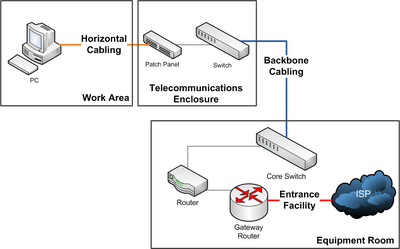
Ethernet over twisted-pair technologies use twisted-pair cables for the physical layer of an Ethernet computer network. They are a subset of all Ethernet physical layers.

Category 5 cable (Cat 5) is a twisted pair cable for computer networks. Since 2001, the variant commonly in use is the Category 5e specification (Cat 5e). The cable standard provides performance of up to 100 MHz and is suitable for most varieties of Ethernet over twisted pair up to 2.5GBASE-T but more commonly runs at 1000BASE-T speeds. Cat 5 is also used to carry other signals such as telephone and video.
Category 3 cable, commonly known as Cat 3 or station wire, and less commonly known as VG or voice-grade, is an unshielded twisted pair (UTP) cable used in telephone wiring. It is part of a family of standards defined jointly by the Electronic Industries Alliance (EIA) and the Telecommunications Industry Association (TIA) and published in TIA/EIA-568-B.

Components of an electrical circuit are electrically connected if an electric current can run between them through an electrical conductor. An electrical connector is an electromechanical device used to create an electrical connection between parts of an electrical circuit, or between different electrical circuits, thereby joining them into a larger circuit. Most electrical connectors have a gender – i.e. the male component, called a plug, connects to the female component, or socket. The connection may be removable, require a tool for assembly and removal, or serve as a permanent electrical joint between two points. An adapter can be used to join dissimilar connectors.

In telephony, the demarcation point is the point at which the public switched telephone network ends and connects with the customer's on-premises wiring. It is the dividing line which determines who is responsible for installation and maintenance of wiring and equipment—customer/subscriber, or telephone company/provider. The demarcation point varies between countries and has changed over time.
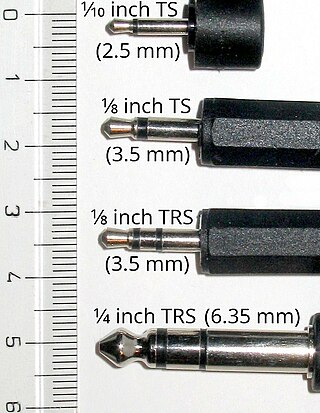
A phone connector is a family of cylindrically-shaped electrical connectors primarily for analog audio signals. Invented in the late 19th century for telephone switchboards, the phone connector remains in use for interfacing wired audio equipment, such as headphones, speakers, microphones, mixing consoles, and electronic musical instruments. A male connector, is mated into a female connector, though other terminology is used.

A registered jack (RJ) is a standardized telecommunication network interface for connecting voice and data equipment to a service provided by a local exchange carrier or long distance carrier. Registered interfaces were first defined in the Universal Service Ordering Code (USOC) system of the Bell System in the United States for complying with the registration program for customer-supplied telephone equipment mandated by the Federal Communications Commission (FCC) in the 1970s. They were subsequently codified in title 47 of the Code of Federal Regulations Part 68. Registered jack connections began to see use after their invention in 1973 by Bell Labs. The specification includes physical construction, wiring, and signal semantics. Accordingly, registered jacks are primarily named by the letters RJ, followed by two digits that express the type. Additional letter suffixes indicate minor variations. For example, RJ11, RJ14, and RJ25 are the most commonly used interfaces for telephone connections for one-, two-, and three-line service, respectively. Although these standards are legal definitions in the United States, some interfaces are used worldwide.

A telephone jack and a telephone plug are electrical connectors for connecting a telephone set or other telecommunications apparatus to the telephone wiring inside a building, establishing a connection to a telephone network. The plug is inserted into its counterpart, the jack, which is commonly affixed to a wall or baseboard. The standards for telephone jacks and plugs vary from country to country, though the 6P2C style modular plug has become by far the most common type.

A standard Swedish telephone plug carries one telephone line and has four flat metal pins and one plastic pin. The design is only used by Televerket in Sweden and older Póstur og Sími installations in Iceland. Neither plug nor socket is compatible with other plugs and sockets. It is defined in Swedish Standard SS 455 15 50.
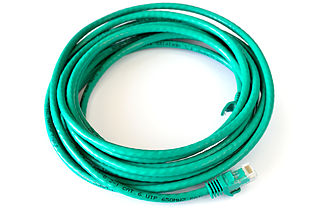
Category 6 cable (Cat 6) is a standardized twisted pair cable for Ethernet and other network physical layers that is backward compatible with the Category 5/5e and Category 3 cable standards.

A 110 block is a type of punch-down block used to terminate runs of on-premises wiring in a structured cabling system. The designation 110 is also used to describe a type of insulation displacement contact (IDC) connector used to terminate twisted pair cables, which uses a punch-down tool similar to the type used for the older 66 block.
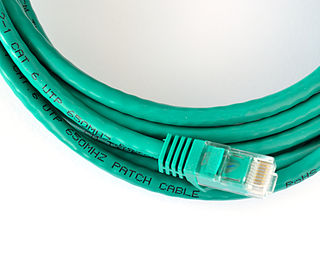
A patch cable, patch cord or patch lead is an electrical or optical cable used to connect one electronic or optical device to another for signal routing. Devices of different types are connected with patch cords.
International standard ISO/IEC 11801Information technology — Generic cabling for customer premises specifies general-purpose telecommunication cabling systems that are suitable for a wide range of applications. It is published by ISO/IEC JTC 1/SC 25/WG 3 of the International Organization for Standardization (ISO) and the International Electrotechnical Commission (IEC). It covers both balanced copper cabling and optical fibre cabling.

A modular connector is a type of electrical connector for cords and cables of electronic devices and appliances, such as in computer networking, telecommunication equipment, and audio headsets.

A keystone module is a standardized snap-in package for mounting a variety of low-voltage electrical jacks or optical connectors into a keystone wall plate, face plate, surface-mount box, or a patch panel.
In copper twisted pair wire networks, copper cable certification is achieved through a thorough series of tests in accordance with Telecommunications Industry Association (TIA) or International Organization for Standardization (ISO) standards. These tests are done using a certification-testing tool, which provide pass or fail information. While certification can be performed by the owner of the network, certification is primarily done by datacom contractors. It is this certification that allows the contractors to warranty their work.
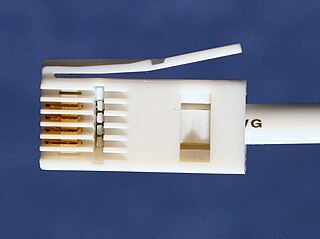
British telephone sockets were introduced in their current plug and socket form on 19 November 1981 by British Telecom to allow subscribers to connect their own telephones. The connectors are specified in British Standard BS 6312. Electrical characteristics of the telephone interface are specified by individual network operators, e.g. in British Telecom's SIN 351. Electrical characteristics required of British telephones used to be specified in BS 6305.
ANSI/TIA-568 is a technical standard for commercial building cabling for telecommunications products and services. The title of the standard is Commercial Building Telecommunications Cabling Standard and is published by the Telecommunications Industry Association (TIA), a body accredited by the American National Standards Institute (ANSI).
The EtherCON is a ruggedized and lockable connector for Ethernet over twisted pair wiring. It is manufactured by Neutrik and is designed for professional audio and stage lighting network applications.

Fiber to the office (FTTO) is an alternative cabling concept for local area network (LAN) network office environments. It combines passive elements and active mini-switches to provide end devices with Gigabit Ethernet. FTTO involves centralised optical fibre cabling techniques to create a combined backbone/horizontal channel; this channel is provided from the work areas to the centralised cross-connect or interconnect by allowing the use of pull-through cables or splices in the telecommunications room.

